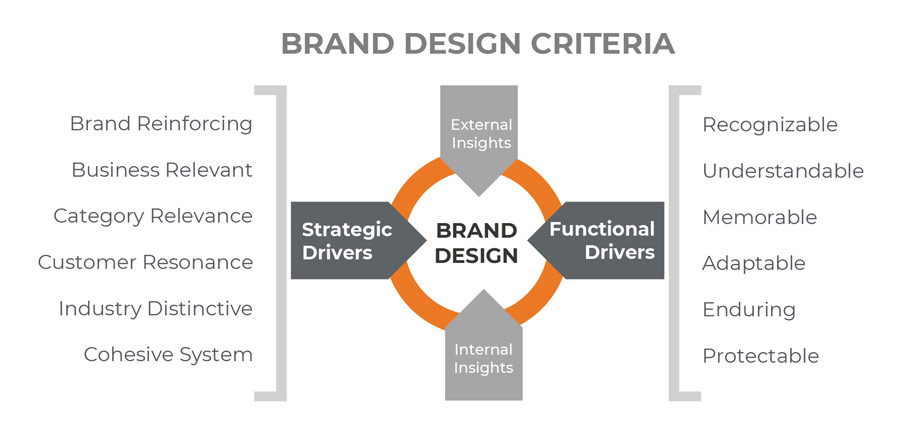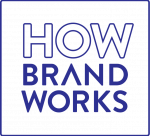Making brand design decisions isn’t easy even for design professionals. Clients who may not be so versed in design principles find it even more difficult. A name, logo, or other key brand expressions will shape competitive distinction and recognition. It’s a long-term investment. And it’s a decision that deserves careful consideration. Getting it wrong could be costly and detrimental to the brand and the business.
Making the Right Decision
Whether this is a new brand or re-branding initiative, decision-making has the same challenges and pitfalls. But there are a few things you can do to help make the right decision.
1. Agree on the Criteria
The criteria that you agree on to guide the design process is the same criteria you will use to inform a decision. Criteria development is the most important step in the design process. So take the time to identify what will lead to the most effective solution. Regardless of whether it’s a name or logo, there are many things to consider.


Strategic criteria will ensure that the design reinforces the brand platform. Brand attributes, value proposition, and brand promise are all important strategic considerations. However, functional criteria must also be accounted for. For example that would include recognition, retention, and protect-ability. And finally, there are external and internal insights that should reflect what will resonate with internal and external audiences. These should be defined and agreed upon in advance. That will ensure the outcome will match the objectives. Failing to get everyone on the same page will jeopardize the end result.
2. Decide on How to Decide
The design process will go through several steps. At each juncture, key decisions will determine the work in the following steps. Consider who can speak into and advise on the process? Who has the authority to make decisions? What are the inputs to the process to inform the decision-making? And when and what kind of decisions are made at each step in the process?
Larger organizations may require more complex decision structures. The work may start with an inter-disciplinary project team and eventually ladder up to the C-suite or board of directors. Smaller organizations may only have two or three people involved in the decision process. Figuring this out from the beginning will save time, grief, and frustration. But it’s essential that everyone involved in the process be on board with the criteria and engaged in the work.
3. Keep an Open Mind
It’s easy to shoot down an idea. It’s much harder to resist your intuition that you just don’t like a concept. If you go into the process with a preconceived idea then you will likely be frustrated and disappointed. Anything you see will fall short of your expectation. Give the process a chance. Listen to your advisors. Weigh the work against the criteria you agreed on from the beginning. Most importantly consider the potential of an idea. That’s where great design solutions come from. Leadership in the process is a function of seeing what something could be as opposed to what it is.
4. Let The Experts Give Expert Advice
Unless you are doing this work yourself you have most likely engaged an experienced brand professional. The right branding partner should have the experience and expertise that you can rely on. They can be an invaluable collaborative partner in the process. They won’t make the decisions for you. But they should be able to provide direction and advice that will help you make the right decision. Their job is to educate, inform, explore, recommend and guide brand design decisions. But the final decision is yours.
5. There Is No Perfect Answer
You are going to be frustrated if you are looking for the perfect solution. There is no perfect solution. Like any business decision, all you can do is make the best decision with the information you have in hand. There is always a risk. But that can be mitigated. Just trust the process and use discernment. Trying to get the perfect solution will only get in the way of the right decision.
Don’t Make These Mistakes
The brand design process can be stimulating and inspiring. Brand design is about shaping the future of what your brand expression could be. Making the right decisions along the way can be challenging and sometimes intimidating. Even with the best intentions, there is always the fear of getting it wrong. But the chances of getting it right are much higher if you follow the right path, with the right attitude, patience and commitment. There are, however, some pitfalls you don’t want to fall victim to.
Emotion Will Lead You Down the Wrong Path
Don’t let your emotions sway you away from an objective business decision. It’s easy to get excited about a design that intuitively looks cool and distinctive. Don’t get so enamored with it that you overlook and disregard the flaws. It’s as important to recognize what doesn’t work as much as what does. That will allow you to weigh the pros and cons of any design considerations.
Research Can Kill a Good Idea
While research is invaluable in providing important insights it can also kill a more creative idea. Breaking new ground with a design means going beyond expectations. It can be uncomfortable. But companies like Apple and Uber were willing to take that risk.
Brand Design is Not Democratic
The brand design decision-making process is not democratic. Don’t make the mistake of inviting employees to vote on a design. The intentions may be good. But it can easily go wrong. You wouldn’t have your employees vote on the best business plan or marketing plan. Why would you invite them to sway the decision on your brand expression? Keep employees informed of the process is a better approach to secure buy-in.
A Preconceived Idea is a Bad Idea
You may think that you already have a solution in mind. It’s just a matter of everyone else coming to the same conclusion. That will be frustrating to all involved. And it jeopardizes the integrity and effectiveness of the process. A preconceived idea is not uncommon. Sometimes letting it go is the best thing you can do to get to a result that will better meet your business objectives.
Make the Most of the Opportunity
The decisions you make in the brand design process will have long-term effects on building brand value and equity. It’s a unique opportunity. Getting it right can be rewarding in many different ways. Getting it wrong can be disappointing at the very least and damaging to the business at its worst. Take the time, enlist the best advice, believe in the process, and be open to the potential. That’s how a great brand works.



